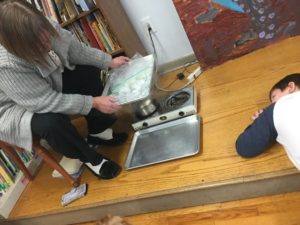We began our study of the water cycle by identifying where we can find water throughout the earth. Did you know that about 97% of the earth’s water is salt water? And that most of the fresh water is frozen in glaciers and the polar ice caps?
As we continued learning about evaporation, condensation, and precipitation, we had questions about a single water drop. That led to us learning about water molecules and performing experiments to learn about surface tension.
We had several activities that focused on the complete water cycle. We each created a mini water cycle in a closed baggie. Over several days we observed the liquid water evaporate from the cup, condense on the baggie, and precipitate, dripping down and collecting on the bottom of the baggie. We observed in the end that we still had the same amount of water that we started with. We demonstrated the water cycle using the heat from a burner to represent the sun’s heat and ice on a pan to represent cooler air in the upper atmosphere, watching water from a teakettle evaporate, condense on the bottom of the cold pan, precipitate in droplets, and then collect in a puddle on another pan.
Notable among the books we read to clarify our understanding of the water cycle and related concepts were Did a Dinosaur Drink This Water? by Robert E. Wells; The Snowflake: A Water Cycle Story, by Neil Waldman; and Raindrops Roll, by April Pulley Sayre.
